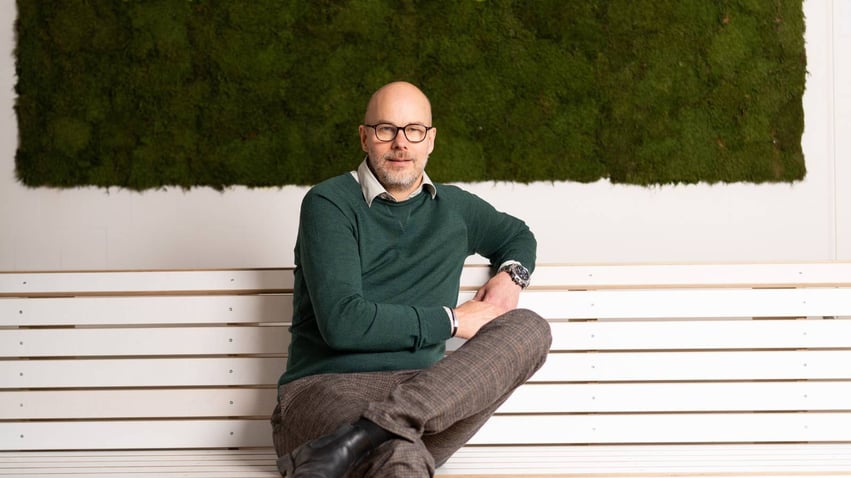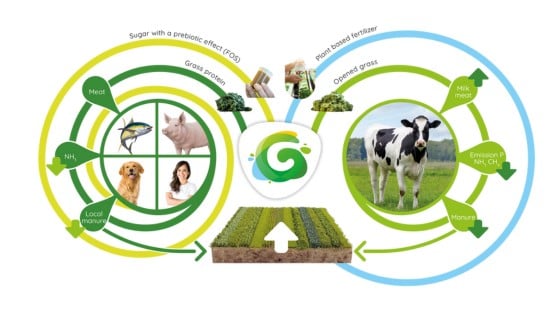RootCamp startup Grassa from the Netherlands is transforming the agricultural landscape by maximizing the potential of green biomass and creating a sustainable circular economy. In this article, we explore how Grassa's circularity concept works, the environmental benefits of using grass as a protein source, their contributions to a sustainable circular economy, and their future plans for expanding their impact.
 CEO of Grassa Rieks Smook from the Netherlands at the RootCamp headquarters.
CEO of Grassa Rieks Smook from the Netherlands at the RootCamp headquarters.
Traditional livestock farming heavily relies on imported soy as a protein source. How does Grassa's circularity concept offer a more sustainable solution for protein production?
Grassa maximizes the productivity of existing land by utilizing green biomass, which currently has limited use. Through this process, we are able to extract green protein, sugars, minerals, and open fibers. Notably, the green protein derived from this biomass contains 17% more essential amino acids than soy, making it an ideal locally grown, plant-based protein for human consumption and a viable alternative to soy in animal feed.
To establish our green refinery infrastructure, we will leverage the existing harvesting infrastructure for grass, which happens to be the largest cultivated crop in Europe, accounting for one-third of all crops. The extensive harvesting season of grass, coupled with its widespread cultivation, provides us with a readily available resource. By using grass as our raw material, we can make the most of the entire plant, including its fiber component known as opened grass. This fiber product is just as effective as the original grass in terms of milk production, but with reduced emissions of ammonia and phosphate.
By implementing the Grassa process on less than 25% of the current grassland, we can generate a sufficient amount of locally grown protein to replace the need for soy imports entirely. This means that the alternative to soy is already present on the land; it simply requires proper harvesting and processing.
What are some of the key environmental benefits of using grass as an alternative protein source?
At least 50% more food can be harvested from the same area of grassland when utilizing Grassa's infrastructure. By incorporating other forms of green biomass, such as horticulture and sugar beets, we can generate an even greater supply of high-quality protein without requiring additional land usage. These additional food products have a low carbon footprint since they do not require additional land, and they effectively replace imported foods with high environmental footprints, such as soy.
Moreover, the sugars and minerals derived from this process are applied more efficiently, using precision fertilization techniques that prevent spillage into groundwater and minimize waste. The opened fiber, when digested by bacteria, exhibits significantly better efficiency compared to unprocessed fiber. This enhances various applications like composting, fermentation, and biogas production, resulting in improved yields and efficiency.
Regarding the opened grass fiber, cows, or more specifically, the bacteria within the cows, digest the grass more effectively. As a result, the extraction of green protein from grass does not hinder milk production; instead, it enhances nitrogen efficiency and reduces ammonia emissions.
Describe how you contribute to a sustainable circular economy with Grassa?
 Circular economy explanation based on the example of grassa's product. Graphic: Grassa
Circular economy explanation based on the example of grassa's product. Graphic: Grassa
The image above illustrates the circularity of the process. In summary, the proteins that would have been processed by cows in their manure are now extracted before the cows consume the grass. The fibers have been optimized to improve efficiency, allowing the cows to produce the same amount of milk while emitting fewer greenhouse gases and reducing nitrogen content in the manure. The extracted grass protein is then used in human food and monogastric animal feed, replacing the need for soy imports.
Although the animals will still produce manure, this manure will now originate locally instead of being linked to the origin of soy. It is important to bring this manure back to the grassland to complete the circular system. By reducing the amount of cow manure, which contains nitrogen, and incorporating grass protein-based manure from monogastric animals, we can close the nitrogen cycle. This ensures a sustainable and self-sufficient process.
How does the technology behind extracting surplus proteins from grass work, and what are the main challenges you faced during the development process?
.jpg?width=668&height=376&name=grassa%20technology(1).jpg) Through a natural process of pressing, heating and filtering, Grassa unlocks the full nutritional value of grass. Photo: Grassa
Through a natural process of pressing, heating and filtering, Grassa unlocks the full nutritional value of grass. Photo: Grassa
The technology used in extracting surplus involves a process of pressing, heating, and filtering. The key lies in applying the appropriate pressure to the specific biomass to achieve high protein yield and open fibers. Filtration techniques are continually evolving, with ongoing advancements in the field. Currently, the green juice containing proteins still requires heating for extraction, but new filtration methods are being developed to enable protein extraction without this heating step. This non-heating extraction method enhances the functional properties of the protein and reduces the energy requirements for extraction. One of the significant challenges in the process is managing the substantial amount of water involved and addressing the logistical aspects of handling the fresh biomass.
What makes RootCamp interesting for your startup?
Many challenges in the Netherlands are similar to those in Germany. The concept requires all the support it can get, particularly from established agricultural companies. Rootcamp serves as a gateway to German strategic investors for Grassa. Through Rootcamp's partners and network, Grassa has the opportunity to attract German investors, which would greatly facilitate the rollout of the concept in a German context.
Looking ahead, what are your future plans and aspirations for Grassa? How do you envision the role of alternative proteins, such as grass protein, in the global food landscape?
We envision an agricultural system that goes beyond harvesting and processing just the seeds, roots, and fruits of plants. Our vision includes harnessing the nutrients from green biomass as well. In the next 10 years, it will become commonplace to bio-refine a portion of the grass, alongside the traditional practice of silaging the entire grass. This expanded infrastructure will also be utilized to process other biomass, increasing efficiency and adding more value to agricultural practices.
A significant part of the grass and other green protein will be utilized as human food, contributing to the protein transition (Phase 1). The remaining portion will be used as locally grown feed for our animals, supporting the protein transition (Phase 2) in animal farming. Sugars and minerals will be applied precisely where they are needed the most, optimizing their use and minimizing waste. Additionally, the opened fiber will enhance bacterial digestion processes such as composting, biogas digestion, and animal digestion, making them more efficient.
By harnessing the power of green biomass and implementing a sustainable circular economy, Grassa is paving the way for a more efficient and environmentally friendly protein production system. If you are a startup looking to make a meaningful impact in the agricultural sector, seize the opportunity to be a part of the new RootCamp batch. Applications are now open until August 1st.
/rootcamp_logo_white_2022.png?width=2123&height=630&name=rootcamp_logo_white_2022.png)

/RC%20logo%202022.png?width=2325&height=703&name=RC%20logo%202022.png)






